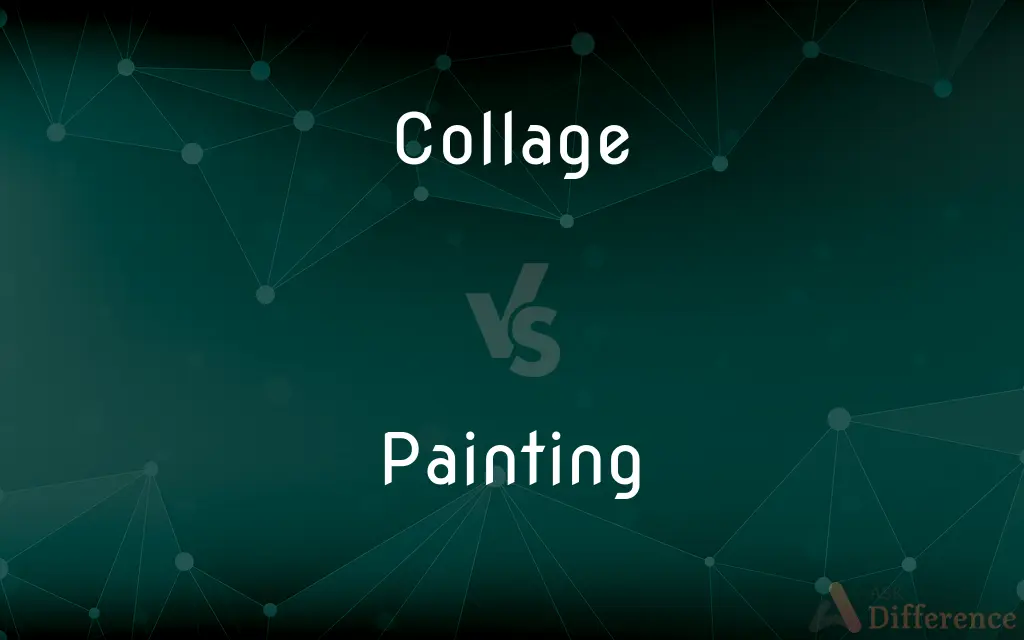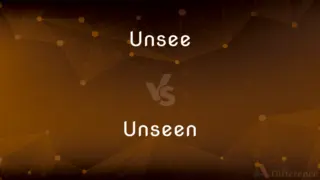Collage vs. Painting — What's the Difference?
By Fiza Rafique & Urooj Arif — Updated on April 23, 2024
Collage involves assembling different materials to create artwork, whereas painting is the art of applying pigment to a surface.

Difference Between Collage and Painting
Table of Contents
ADVERTISEMENT
Key Differences
Collage is an artistic technique where various materials such as paper, photographs, and fabric are assembled on a surface to create a new whole. In contrast, painting involves applying colored pigments in a liquid medium to a solid surface, typically using brushes or knives to create visual art.
While collage is characterized by its use of diverse textures, layers, and the concept of mixed media, painting focuses more on the application of colors, strokes, and the effects of light and shadow. Paintings tend to convey depth and realism through the painter's technique.
Artists creating collages often incorporate elements of recycling and reusing, bringing together unrelated objects to form cohesive works. On the other hand, painters typically work with new materials, focusing on blending and layering colors directly on canvases or other bases.
Collage can be a more accessible art form for beginners, as it allows for experimentation without the need for advanced drawing skills. Conversely, painting can require a deeper understanding of color theory, composition, and technique, which often necessitates more formal training.
While collage art is seen as a modern and experimental genre that challenges traditional boundaries of art-making, painting is often viewed as a classical form that has evolved over centuries with established techniques and styles.
ADVERTISEMENT
Comparison Chart
Medium
Various materials (paper, fabric, etc.)
Pigments applied to surfaces
Technique
Assembling and layering materials
Applying paint with tools like brushes
Texture
Varied, multi-dimensional
Typically flat and smooth
Skill Level
Accessible to beginners
Often requires more formal training
Artistic Perception
Modern, experimental
Classical, focused on traditional aesthetics
Compare with Definitions
Collage
A creative method involving the assembly of different forms to create new art.
His collage combined photographs with hand-drawn elements.
Painting
The practice of creating art with paint and a brush.
She took classes to improve her painting skills.
Collage
An artwork that physically incorporates various objects for aesthetic purposes.
Her collage incorporated buttons and dried flowers, creating a tactile experience.
Painting
A technique used to represent visual phenomenon on a flat surface.
His painting technique emphasized light and shadow.
Collage
A form of mixed media art that breaks traditional boundaries.
The workshop on collage explored innovative ways to use recycled materials.
Painting
The action of applying paint to a surface.
Painting the mural took over three weeks.
Collage
A technique in visual arts that emphasizes layering and juxtaposition.
The artist's collage featured a complex layering of paper and foil.
Painting
An artwork created through the application of pigments.
The gallery displayed a painting from the Renaissance period.
Collage
An artistic composition made of various materials glued on a surface.
She created a collage using old magazine clippings and fabric scraps.
Painting
A work produced by applying colors on a canvas or board.
The vibrant colors in that painting captured the sunset beautifully.
Collage
Collage (, from the French: coller, "to glue" or "to stick together";) is a technique of art creation, primarily used in the visual arts, but in music too, by which art results from an assemblage of different forms, thus creating a new whole. (Compare with pastiche, which is a "pasting" together.) A collage may sometimes include magazine and newspaper clippings, ribbons, paint, bits of colored or handmade papers, portions of other artwork or texts, photographs and other found objects, glued to a piece of paper or canvas.
Painting
Painting is the practice of applying paint, pigment, color or other medium to a solid surface (called the "matrix" or "support"). The medium is commonly applied to the base with a brush, but other implements, such as knives, sponges, and airbrushes, can be used.
Collage
A piece of art made by sticking various different materials such as photographs and pieces of paper or fabric on to a backing.
Painting
The process, art, or occupation of coating surfaces with paint for a utilitarian or artistic effect.
Collage
An artistic composition of materials and objects pasted over a surface, often with unifying lines and color.
Painting
A picture or design in paint.
Collage
A work, such as a literary piece, composed of both borrowed and original material.
Painting
Present participle of paint
Collage
The art of creating such compositions.
Painting
(countable) An illustration or artwork done with the use of paint.
The Mona Lisa is one of the most famous paintings.
Collage
An assemblage of diverse elements
A collage of conflicting memories.
Painting
(uncountable) The action of applying paint to a surface.
The outside of the old house would benefit from some painting.
Collage
To paste (diverse materials) over a surface, thereby creating an artistic product.
Painting
(uncountable) The same activity as an art form.
Some artists, like Michelangelo, excel in both painting and sculpture.
Collage
To create such an artistic product.
Painting
The act or employment of laying on, or adorning with, paints or colors.
Collage
A picture made by sticking other pictures onto a surface.
Painting
The work of the painter; also, any work of art in which objects are represented in color on a flat surface; a colored representation of any object or scene; a picture.
Collage
A composite object or collection (abstract or concrete) created by the assemblage of various media; especially for a work of art such as text, film, etc.
Richard Brautigan's novel So the Wind Won't Blow It All Away is a collage of memories.
Painting
Color laid on; paint.
Collage
(uncountable) The technique of producing a work of art of this kind.
Painting
A depicting by words; vivid representation in words.
Collage
(transitive) To make into a collage.
Collage the picture together.
Painting
Graphic art consisting of an artistic composition made by applying paints to a surface;
A small painting by Picasso
He bought the painting as an investment
His pictures hang in the Louvre
Collage
Any picture made by sticking together pieces of paper or photographs, especially in unusual or surprising ways.
Painting
Creating a picture with paints;
He studied painting and sculpture for many years
Collage
The technique of producing a work of art that is a collage{1}.
Painting
The act of applying paint to a surface;
You can finish the job of painting faster with a roller than with a brush
Collage
Any composite object, whether abstract or concrete, created by assembling components of varied types.
Painting
The occupation of a house painter;
House painting was the only craft he knew
Collage
A film having scenes of different types or from different locations displayed in rapid succession without transitions.
Collage
A paste-up made by sticking together pieces of paper or photographs to form an artistic image;
He used his computer to make a collage of pictures superimposed on a map
Collage
Any collection of diverse things;
A collage of memories
Common Curiosities
What materials are commonly used in collage?
Common materials include paper, fabric, photographs, and other found objects.
What are the primary techniques used in painting?
Techniques include brushwork, blending, and layering of paints.
What is the historical significance of painting compared to collage?
Painting has a long, rich history in art culture, dating back to ancient times, whereas collage became prominent in the 20th century as part of modern art movements.
How does the texture of collage and painting differ?
Collage often has a varied, tactile texture due to its layered materials, while painting is generally smoother.
Do both collage and painting require artistic talent?
Both forms require creativity, but collage can be more accessible for those without traditional art skills.
How do environmental concerns impact collage artists compared to painters?
Collage artists often use recycled materials, which can be seen as environmentally friendly, while painters need to be mindful of the environmental impact of their paints and solvents.
Can collage incorporate painting techniques?
Yes, collage can incorporate painting as part of the layered materials.
Is collage considered less valuable than painting in the art world?
Not necessarily; the value often depends on the artist's reputation, the piece's uniqueness, and its artistic impact.
What is one way painting has evolved with modern technology?
Modern technology has introduced new forms of painting, including digital painting tools that simulate traditional painting techniques on digital canvases.
How do beginners approach collage differently from painting?
Beginners may find collage more forgiving and flexible, as it allows for adjustments and additions without the need for technical skill in drawing or painting.
Can digital tools be used for making collages?
Yes, digital tools can create virtual collages, allowing for manipulation of images and materials digitally.
What educational paths are common for aspiring painters and collage artists?
Aspiring painters often pursue formal art education to master techniques, whereas collage artists might focus on conceptual art education or self-taught methods.
How do exhibitions differ for collage versus painting?
Collage exhibitions might focus on the innovative use of materials and conceptual art, while painting exhibitions often highlight technical skill and historical styles.
What are common themes explored in collage that might differ from painting?
Collage often explores themes of modernity, technology, and socio-political commentary through its eclectic materials, whereas painting may focus more on classical themes like nature, human emotion, and historical narratives.
Are there famous artists known for both collage and painting?
Artists like Pablo Picasso and Henri Matisse are known for both their paintings and their innovative use of collage.
Share Your Discovery

Previous Comparison
Unsee vs. Unseen
Next Comparison
Rhetoric vs. DiscourseAuthor Spotlight
Written by
Fiza RafiqueFiza Rafique is a skilled content writer at AskDifference.com, where she meticulously refines and enhances written pieces. Drawing from her vast editorial expertise, Fiza ensures clarity, accuracy, and precision in every article. Passionate about language, she continually seeks to elevate the quality of content for readers worldwide.
Co-written by
Urooj ArifUrooj is a skilled content writer at Ask Difference, known for her exceptional ability to simplify complex topics into engaging and informative content. With a passion for research and a flair for clear, concise writing, she consistently delivers articles that resonate with our diverse audience.














































